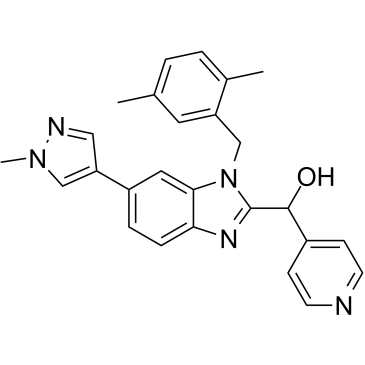UCB-9260 (UCB9260; UCB 9260) is an oral anti-inflammatory drug that may be used to treat autoimmune conditions like Crohn's disease and rheumatoid arthritis. It functions as a TNF inhibitor, preventing TNF signaling by maintaining an asymmetric form of the trimer. After stimulating Hek-293 cells with TNF (10 pM), UCB-9260 inhibits NF-κB in vitro with a geometric mean IC50 of 202 nM. In a mouse rheumatoid arthritis-CIA model, UCB-9260 significantly lowers the clinical score in vivo.
Physicochemical Properties
| Molecular Formula | C26H25N5O |
| Molecular Weight | 423.509605169296 |
| Exact Mass | 423.21 |
| Elemental Analysis | C, 73.74; H, 5.95; N, 16.54; O, 3.78 |
| CAS # | 1515888-53-5 |
| Related CAS # | 1515888-53-5 |
| PubChem CID | 72700327 |
| Appearance | Brown to gray solid |
| LogP | 3.5 |
| Hydrogen Bond Donor Count | 1 |
| Hydrogen Bond Acceptor Count | 4 |
| Rotatable Bond Count | 5 |
| Heavy Atom Count | 32 |
| Complexity | 613 |
| Defined Atom Stereocenter Count | 0 |
| InChi Key | RZGFWGNCSYUEPR-UHFFFAOYSA-N |
| InChi Code | InChI=1S/C26H25N5O/c1-17-4-5-18(2)21(12-17)16-31-24-13-20(22-14-28-30(3)15-22)6-7-23(24)29-26(31)25(32)19-8-10-27-11-9-19/h4-15,25,32H,16H2,1-3H3 |
| Chemical Name | [1-[(2,5-dimethylphenyl)methyl]-6-(1-methylpyrazol-4-yl)benzimidazol-2-yl]-pyridin-4-ylmethanol |
| Synonyms | UCB-9260; UCB9260; UCB 9260 |
| HS Tariff Code | 2934.99.9001 |
| Storage |
Powder-20°C 3 years 4°C 2 years In solvent -80°C 6 months -20°C 1 month |
| Shipping Condition | Room temperature (This product is stable at ambient temperature for a few days during ordinary shipping and time spent in Customs) |
Biological Activity
| Targets | TNF (Kd = 13 nM); NF-κB (Kd = 202 nM) | |
| ln Vitro |
|
|
| ln Vivo |
|
|
| References |
[1]. Small molecules that inhibit TNF signalling by stabilising an asymmetric form of the trimer.Nat Commun. 2019 Dec 19;10(1):5795. |
Solubility Data
| Solubility (In Vitro) | DMSO: 85~125 mg/mL (200.7~295.2 mM) |
| Solubility (In Vivo) |
Solubility in Formulation 1: ≥ 6.25 mg/mL (14.76 mM) (saturation unknown) in 10% DMSO + 40% PEG300 +5% Tween-80 + 45% Saline (add these co-solvents sequentially from left to right, and one by one), clear solution. For example, if 1 mL of working solution is to be prepared, you can add 100 μL of 62.5 mg/mL clear DMSO stock solution to 400 μL PEG300 and mix evenly; then add 50 μL Tween-80 + to the above solution and mix evenly; then add 450 μL normal saline to adjust the volume to 1 mL. Preparation of saline: Dissolve 0.9 g of sodium chloride in 100 mL ddH₂ O to obtain a clear solution. (Please use freshly prepared in vivo formulations for optimal results.) |
| Preparing Stock Solutions | 1 mg | 5 mg | 10 mg | |
| 1 mM | 2.3612 mL | 11.8061 mL | 23.6122 mL | |
| 5 mM | 0.4722 mL | 2.3612 mL | 4.7224 mL | |
| 10 mM | 0.2361 mL | 1.1806 mL | 2.3612 mL |
